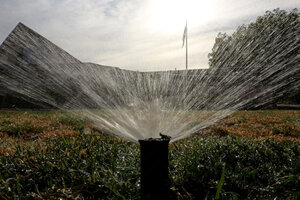California drought hits home: reckless lawn-watering could cost $500
The California water board has passed new restrictions to rein in water use amid the worst drought in state history. Until now, residents in big cities and suburbs have been largely shielded from the drought's effects.

Sprinklers water a lawn Tuesday in Sacramento, Calif. In an effort to force the public to conserve water, the State Water Resources Control Board voted 4 to 0 to approve a proposal that includes fines up to $500 a day for people who waste water on landscaping, fountains, washing vehicles, and other outdoor uses.
Rich Pedroncelli/AP
Los Angeles
Gov. Jerry Brown gave California residents the chance to prove that they could conserve water amid the worst drought in state history.
So much for that idea.
On Tuesday, State Water Resources Control Board passed strict new statewide watering restrictions that cover hose-washing a car without a shutoff nozzle, overwatering lawns so that runoff floods sidewalks and gutters, using water to clean driveways and sidewalks, and operating fountains without recirculation. The board authorized fines of up to $500 per day. The rules take effect Aug. 1.
In January, Governor Brown called for a 20 percent cut in water use, but the state has actually increased use by 1 percent.
The board “found that scores of water suppliers had not invoked any provisions of their local drought contingency plans, even as California experienced its driest year on record since becoming a state over 150 years ago,” says Ed Osann, senior policy analyst with the Natural Resources Defense Council.
Part of the problem is that cities have been so effective in managing water resources that they have shielded residents from feeling the impact of water wastefulness, says Mr. Osann.
A major drought from 1987 to 1992 frightened metropolitan officials into designing all kinds of water purchasing, storing, and delivery options, including making use of new ways to catch and retain storm water and recycle waste water for all uses but drinking. In addition, San Diego and Los Angeles have agreements to share Colorado River water with districts in the Imperial Valley. A 2003 agreement involved "the largest transfer of water from agricultural use to urban use in US history," according to the Association of California Water Agencies (ACWA).
“California cities really got their act together and began coming up with formal drought plans two decades ago,” says Timothy Quinn, ACWA executive director. “Now, they’re reaping the benefits of that planning.”
But that foresight that created a lag in urban residents perceiving just how devastating the drought has been for the state that produces half the nation’s fruits and vegetables. While large cities have been living off stored water, farmers have had to subsist on current allocations, which have all but disappeared, analysts say.
Residents “don’t get this drought,” Madelyn Glickfield, assistant director of the Institute of the Environment at the University of California at Los Angeles, told the board Tuesday.
But with the new rules, Californians in the cities and suburbs might be getting the message at last.
“I knew about the drought but figured that was primarily an agricultural problem,” says Tom Wilson, a resident of Sherman Oaks, Calif., at a local coffee shop. “Then I saw my neighbor tearing out his lawn and putting in native plants and succulents. Now, I’m beginning to realize I’ve got to be one to start conserving, or at least not flagrantly wasting it.”
He says he’s not worried about getting fined $500, but “just the same, I’m not going to wash my car in the driveway anymore. The water runs into the gutter and sends a bad signal to everyone else.”
State Water Resources Control Board Chairwoman Felicia Marcus told the Los Angeles Times Tuesday: “This is our attempt to say ... this is the least that urban Californians can do. We're all in this together. "
The board estimates the restrictions could save enough water statewide to supply more than 3.5 million people for a year.

